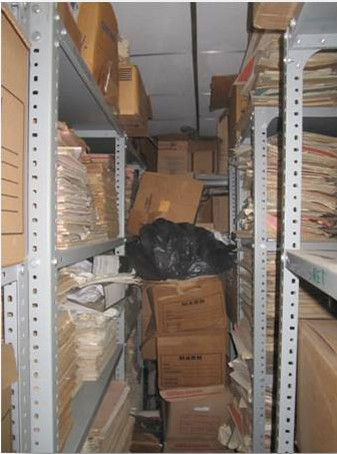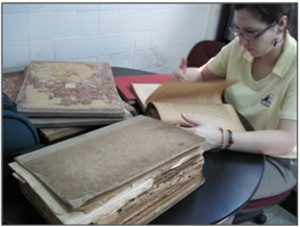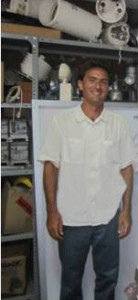 In November 2009, IEDRO visited the El Salvador National Meteorological Service (SNMS) in the capital city of San Salvador to begin rescuing and digitizing thousands of historic hydrometeorological records documented over the last 100 years. IEDRO was able to gather daily precipitation strip charts covering 49 stations over the past 25 years for a total in excess of 300,000 charts from the site’s two warehouses. Dr. Rick Crouthamel, IEDRO’s Executive Director, brought back 2,000 strip charts with him from the trip.
In November 2009, IEDRO visited the El Salvador National Meteorological Service (SNMS) in the capital city of San Salvador to begin rescuing and digitizing thousands of historic hydrometeorological records documented over the last 100 years. IEDRO was able to gather daily precipitation strip charts covering 49 stations over the past 25 years for a total in excess of 300,000 charts from the site’s two warehouses. Dr. Rick Crouthamel, IEDRO’s Executive Director, brought back 2,000 strip charts with him from the trip.
IEDRO is examining and discussing options to accommodate the huge quantity of weather data that can be rescued at the site. While a few thousand charts can be handled by existing volunteers, rescuing the 300,000 pieces of historic data at this site requires developing new approaches and methodologies.
 The availability of historic weather data can help the scientific community anticipate extreme conditions and provide forewarning for possible catastrophes like Hurricane Ida, which hit El Salvador the week before IEDRO’s visit. The torrential downpours set off massive landslides and killed over 200 people. El Salvador lies in the tropics, about thirteen degrees north latitude, and is a land of volcanoes and mountainous terrain. The poorest families construct shanties on these steep slopes while trying to manage a living. Without an adequate warning system equipped with the data necessary for effective forecasting, families have no way to escape impending floods during heavy rain.
The availability of historic weather data can help the scientific community anticipate extreme conditions and provide forewarning for possible catastrophes like Hurricane Ida, which hit El Salvador the week before IEDRO’s visit. The torrential downpours set off massive landslides and killed over 200 people. El Salvador lies in the tropics, about thirteen degrees north latitude, and is a land of volcanoes and mountainous terrain. The poorest families construct shanties on these steep slopes while trying to manage a living. Without an adequate warning system equipped with the data necessary for effective forecasting, families have no way to escape impending floods during heavy rain.
IEDRO’s collection of weather data from this site will be used by computer forecast models to improve flood and mudslide warning capabilities in El Salvador, which will hopefully prepare citizens for future climatic disaster and in turn save hundreds of lives every year.
On Monday June 20th, 2011, IEDRO Chief Operations Officer, Teddy Allen, met with Luis Garcia, Rosa Maria Araujo (user applications), Pablo Ayala (climate prediction), and Ricardo Zimmerman (climate and data base coordinator) to discuss the status of their data rescue operations and goals.
During the meeting, Teddy was introduced to other related personnel and given a tour of their historical data (non-digitized) storage area. The data, consisting of many cabinets and shelves of books, charts, and strip charts, was kept in a storage facility shared by the hydrological group. In addition, the storage unit housed a substantial amount of valuable weather / hydro related instruments. Because of this, the storage area was kept locked and unauthorized visitors were unable to access the area. This made organization and categorization very difficult since the meteorological staff is unable to dedicate enough of their time to the DR&D process; thus discouraging volunteers and others from making an impact.
Unfortunately there are no alternative storage facilities on the property at this time to accommodate the data inventory apart from the instruments. Access to the data could be more liberal if it existed, thus allowing greater access to it and the categorization and imaging process from outside volunteers.
The excitement towards digitizing their precipitation strip charts was tangible. Teddy estimated they had over 300,000 charts ready to be digitized. He discussed progress on IEDRO’s strip chart digitization software.
Project personnel are eager for this endeavor due to their agricultural sensitivities to the well known veranillo (or mid-summer drying) which is especially pronounced in the southeast region of the country near San Miguel. In addition, there is much need for increased data towards a flash flood warning system. Both of these concerns immediately impact the livelihood and economic prosperity of the people.
Overall, this visit allowed IEDRO to connect with our partners on a personal level and to share our progress with the new IEDRO strip chart software. Site visitations like this one are a valuable component to the development of a productive partnership due to the exchange of information in a personal setting. Their enthusiasm is evident and can be best conveyed directly.

